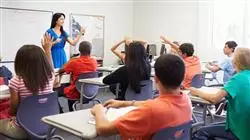University certificate
The world's largest faculty of education”
Introduction to the Program
This Postgraduate diploma in Teaching Programs and Assessment in Art History in High School will generate a sense of confidence in the performance of your profession, which will help you grow personally and professionally"

The advantage of successfully completing this online program for those who take it is firstly, the ease and access to personalized tutoring and all kinds of help and advice; in addition to having at any time and place of the resources provided, being able to have greater autonomy in learning and carrying out the proposed practices.
It considered that teachers should be aware of the course of their discipline over time and the various legislative changes that have occurred in education, thereby seeking to improve their skills when teaching a constantly changing and evolving student body.
Precisely, in the search for the updating of teachers, this Postgraduate diploma offers a special treatment with ICT, so current in our educational system and that are a very attractive vehicle to access the students.
In addition, by learning more about the different methodological and evaluative techniques, the educator will be able to develop the necessary capacity to establish a satisfactory teaching-learning process with the student.
Teaching history is a task of great responsibility, because it is a subject that is linked as a complement to teaching history, knowledge of the past, the present and future, as well as the understanding of the environment, more immediate history, as the most distant. Art history as a discipline aims to help cultivate aesthetic sensibility, fundamental to develop intellectual abstraction. Behind each piece of work, there are many elements, and the search and identification of these elements makes it an indispensable knowledge for high school students.
This Postgraduate diploma offers numerous studies that the teacher of Art History will need to perform their work, looking for innovation and based on practical elements that will have an impact on the work in the classroom. TECH seeks the professional success of those who study this program that will result in the improvement of the educational system and, consequently, of society itself.
Update your knowledge through the Postgraduate diploma in Teaching Programs and Assessment in Art History in High School
This Postgraduate diploma in Teaching Programs and Assessment in Art History in High School contains the most complete and up-to-date educational program on the market. Its most notable features are:
- 75 case studies presented by experts in Teaching Programs and Assessment of Art History in High School. The graphic, schematic, and practical contents with which they are created provide scientific and practical information on the disciplines that are essential for professional practice
- Latest news on Teaching Programs and Assessment in Art History in High School
- It contains practical exercises where the self-assessment process can be carried out to improve learning
- With special emphasis on innovative methodologies in Teaching Programs and Assessment of Art History in High School
- All of this will be complemented by theoretical lessons, questions to the expert, debate forums on controversial topics, and individual reflection assignments
- Content that is accessible from any fixed or portable device with an Internet connection
This Postgraduate diploma may be the best investment you can make when selecting a refresher program, for two reasons: in addition to updating your knowledge in Teaching Programs and Assessment in Art History in High School, you will obtain a qualification from TECH Global University”
It includes in its teaching staff professionals belonging to the field of Methodology and Assessment in Art History in High School, who pour into this program the experience of their work, in addition to recognized specialists belonging to reference societies and prestigious universities.
The multimedia content developed with the latest educational technology will provide the professional with situated and contextual learning, i.e., a simulated environment that will provide an immersive program to learn in real situations.
This program is designed around Problem-Based Learning, whereby the professional must try to solve the different professional practice situations that arise throughout the program. For this purpose, the teachers will be assisted by an innovative interactive video system developed by recognized experts in the field of Methodology and Assessment in Art History in High School with extensive teaching experience.
Increase your decision-making confidence by updating your knowledge with this Postgraduate diploma"

Take the opportunity to learn about the latest advances in Teaching Programs and Assessment in Art History in High School and improve the education of your students"
Why study at TECH?
TECH is the world’s largest online university. With an impressive catalog of more than 14,000 university programs available in 11 languages, it is positioned as a leader in employability, with a 99% job placement rate. In addition, it relies on an enormous faculty of more than 6,000 professors of the highest international renown.

Study at the world's largest online university and guarantee your professional success. The future starts at TECH”
The world’s best online university according to FORBES
The prestigious Forbes magazine, specialized in business and finance, has highlighted TECH as “the world's best online university” This is what they have recently stated in an article in their digital edition in which they echo the success story of this institution, “thanks to the academic offer it provides, the selection of its teaching staff, and an innovative learning method aimed at educating the professionals of the future”
A revolutionary study method, a cutting-edge faculty and a practical focus: the key to TECH's success.
The most complete study plans on the university scene
TECH offers the most complete study plans on the university scene, with syllabuses that cover fundamental concepts and, at the same time, the main scientific advances in their specific scientific areas. In addition, these programs are continuously being updated to guarantee students the academic vanguard and the most in-demand professional skills. In this way, the university's qualifications provide its graduates with a significant advantage to propel their careers to success.
TECH offers the most comprehensive and intensive study plans on the current university scene.
A world-class teaching staff
TECH's teaching staff is made up of more than 6,000 professors with the highest international recognition. Professors, researchers and top executives of multinational companies, including Isaiah Covington, performance coach of the Boston Celtics; Magda Romanska, principal investigator at Harvard MetaLAB; Ignacio Wistumba, chairman of the department of translational molecular pathology at MD Anderson Cancer Center; and D.W. Pine, creative director of TIME magazine, among others.
Internationally renowned experts, specialized in different branches of Health, Technology, Communication and Business, form part of the TECH faculty.
A unique learning method
TECH is the first university to use Relearning in all its programs. It is the best online learning methodology, accredited with international teaching quality certifications, provided by prestigious educational agencies. In addition, this disruptive educational model is complemented with the “Case Method”, thereby setting up a unique online teaching strategy. Innovative teaching resources are also implemented, including detailed videos, infographics and interactive summaries.
TECH combines Relearning and the Case Method in all its university programs to guarantee excellent theoretical and practical learning, studying whenever and wherever you want.
The world's largest online university
TECH is the world’s largest online university. We are the largest educational institution, with the best and widest online educational catalog, one hundred percent online and covering the vast majority of areas of knowledge. We offer a large selection of our own degrees and accredited online undergraduate and postgraduate degrees. In total, more than 14,000 university degrees, in eleven different languages, make us the largest educational largest in the world.
TECH has the world's most extensive catalog of academic and official programs, available in more than 11 languages.
Google Premier Partner
The American technology giant has awarded TECH the Google Google Premier Partner badge. This award, which is only available to 3% of the world's companies, highlights the efficient, flexible and tailored experience that this university provides to students. The recognition as a Google Premier Partner not only accredits the maximum rigor, performance and investment in TECH's digital infrastructures, but also places this university as one of the world's leading technology companies.
Google has positioned TECH in the top 3% of the world's most important technology companies by awarding it its Google Premier Partner badge.
The official online university of the NBA
TECH is the official online university of the NBA. Thanks to our agreement with the biggest league in basketball, we offer our students exclusive university programs, as well as a wide variety of educational resources focused on the business of the league and other areas of the sports industry. Each program is made up of a uniquely designed syllabus and features exceptional guest hosts: professionals with a distinguished sports background who will offer their expertise on the most relevant topics.
TECH has been selected by the NBA, the world's top basketball league, as its official online university.
The top-rated university by its students
Students have positioned TECH as the world's top-rated university on the main review websites, with a highest rating of 4.9 out of 5, obtained from more than 1,000 reviews. These results consolidate TECH as the benchmark university institution at an international level, reflecting the excellence and positive impact of its educational model.” reflecting the excellence and positive impact of its educational model.”
TECH is the world’s top-rated university by its students.
Leaders in employability
TECH has managed to become the leading university in employability. 99% of its students obtain jobs in the academic field they have studied, within one year of completing any of the university's programs. A similar number achieve immediate career enhancement. All this thanks to a study methodology that bases its effectiveness on the acquisition of practical skills, which are absolutely necessary for professional development.
99% of TECH graduates find a job within a year of completing their studies.
Postgraduate Diploma in Teaching Programs and Assessment in Art History in High School
Art is a universal language that connects us with history, culture and creativity. This Postgraduate Diploma in Teaching Programs and Assessment in Art History in High School created by TECH will provide you with the tools and strategies necessary to teach inspiring and effective classes in the field of art history at key educational levels. Delivered online, this program will immerse you in theoretical and practical approaches that will enable you to design sound teaching programs and assess learning in the context of art history. Here, you will explore assessment methods suitable for evaluating learning in art history. Through lectures, case studies, and hands-on exercises, you will learn how to create instructional programs that stimulate understanding and appreciation of artistic manifestations through time. In addition, you'll become familiar with innovative approaches to teaching complex artistic concepts in an accessible and motivating way. Your journey to more enriching and effective teaching begins here!
Get to know the Teaching Programs and Assessment in Art History in High Schooll.
In this Postgraduate Diploma you will learn how to design assessment instruments that reflect the skills and competencies acquired by students in relation to artistic analysis and cultural appreciation. Our team of instructors is composed of experts in pedagogy and art history, with extensive experience in teaching and research. Their knowledge will provide you with a quality education and guide you in the effective application of pedagogical approaches to teaching art history. Upon completion of the program, you will be prepared to conduct enriching classes that foster critical thinking and art appreciation in your students. Your ability to design effective programs and assess learning will make you an exceptional educator in the field of art history. Seize the opportunity to transform art history education. Enroll now and discover how your passion for art can inspire the next generation of art and culture enthusiasts.







